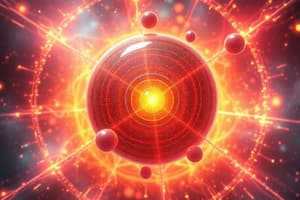Podcast
Questions and Answers
What does the atomic number (Z) represent in an atom?
What does the atomic number (Z) represent in an atom?
- Number of protons (correct)
- Mass number
- Total number of neutrons
- Total number of electrons
Which subatomic particle has a relative charge of +1?
Which subatomic particle has a relative charge of +1?
- Neutron
- Proton (correct)
- Electron
- Photon
Where are neutrons located within an atom?
Where are neutrons located within an atom?
- In the valence layer
- In electron shells
- Outside the nucleus
- In the nucleus (correct)
Which of the following subatomic particles was discovered by James Chadwick?
Which of the following subatomic particles was discovered by James Chadwick?
What is the relative mass of an electron in atomic mass units (amu)?
What is the relative mass of an electron in atomic mass units (amu)?
Study Notes
Properties of Subatomic Particles
- Subatomic particles include protons, neutrons, and electrons, each with distinct properties.
- Proton symbol: p+, with a relative charge of +1, found in the nucleus with a mass of 1 amu.
- Neutron symbol: n0, has no charge (0), located in the nucleus, also with a mass of 1 amu.
- Electron symbol: e-, carries a relative charge of -1, exists outside the nucleus with a much smaller mass of 1/1840 amu.
- Protons were pioneered by Eugen Goldstein and named by Ernest Rutherford.
- James Chadwick discovered neutrons, while Joseph John Thomson is credited with the discovery of electrons.
Atomic Number (Z)
- The atomic number (Z) represents the count of protons in an atom.
- Formula: Z = number of protons (p+).
- In a neutral atom, the number of protons equals the number of electrons, balancing the overall charge.
Studying That Suits You
Use AI to generate personalized quizzes and flashcards to suit your learning preferences.
Description
Test your knowledge on the properties of subatomic particles, including atomic number, mass number, and nuclide notation. This quiz covers the fundamental characteristics of protons, neutrons, and electrons, so you can enhance your understanding of atomic structure.




